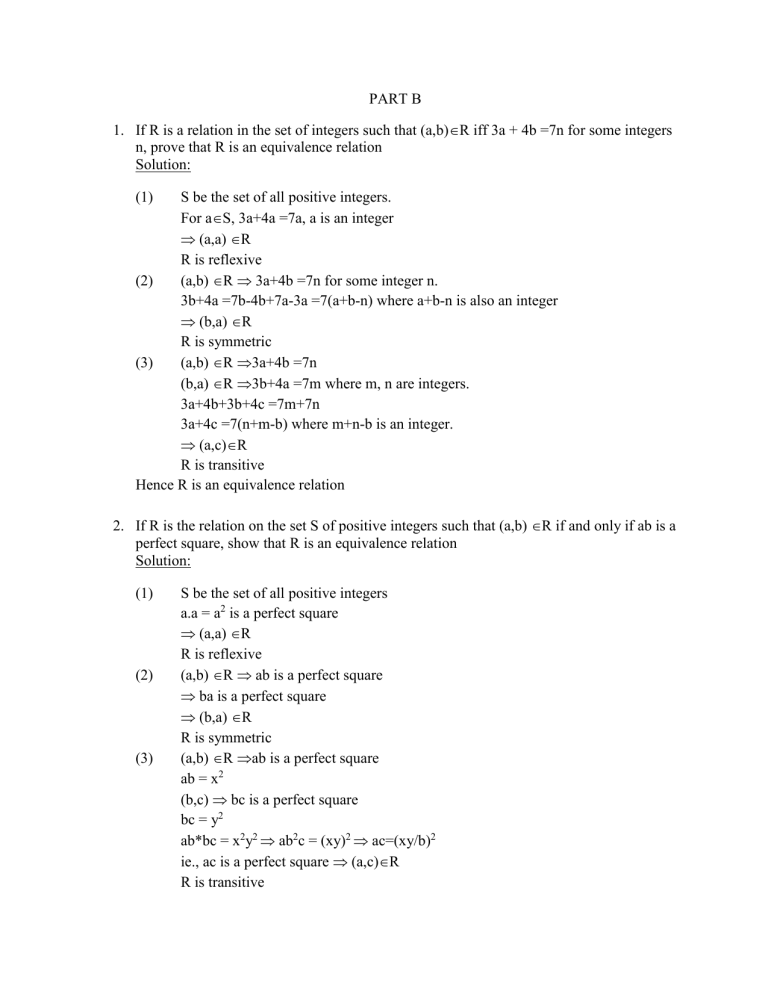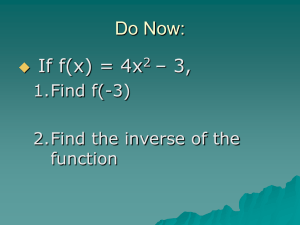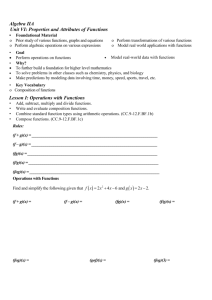Unit 1- Part-B - WordPress.com
advertisement

PART B
1. If R is a relation in the set of integers such that (a,b)R iff 3a + 4b =7n for some integers
n, prove that R is an equivalence relation
Solution:
(1)
S be the set of all positive integers.
For aS, 3a+4a =7a, a is an integer
(a,a) R
R is reflexive
(2)
(a,b) R 3a+4b =7n for some integer n.
3b+4a =7b-4b+7a-3a =7(a+b-n) where a+b-n is also an integer
(b,a) R
R is symmetric
(3)
(a,b) R 3a+4b =7n
(b,a) R 3b+4a =7m where m, n are integers.
3a+4b+3b+4c =7m+7n
3a+4c =7(n+m-b) where m+n-b is an integer.
(a,c)R
R is transitive
Hence R is an equivalence relation
2. If R is the relation on the set S of positive integers such that (a,b) R if and only if ab is a
perfect square, show that R is an equivalence relation
Solution:
(1)
(2)
(3)
S be the set of all positive integers
a.a = a2 is a perfect square
(a,a) R
R is reflexive
(a,b) R ab is a perfect square
ba is a perfect square
(b,a) R
R is symmetric
(a,b) R ab is a perfect square
ab = x2
(b,c) bc is a perfect square
bc = y2
ab*bc = x2y2 ab2c = (xy)2 ac=(xy/b)2
ie., ac is a perfect square (a,c)R
R is transitive
Hence R is an equivalence relation
3. Prove that 8n-3n is divisible by 5, n1 by Mathematical Induction
Solution:
Let P(n): 8n-3n is divisible by 5
(i)
(ii)
P(1)= 81-31 = 5 is multiple of 5
Assume that P(k) is true
8k-3k is a multiple of 5 ie., 8k-3k =5r where r is an integer
(iii)
Consider the statement P(k+1)
8k+1-3k+1 = 8k.8-3k.3 = 8.(5r+3k) -3k.3 = 40r +8.3k-3k.3
= 40r-5.3k =5(8r-3k) is a multiple of 5
P(k+1) is true
P(n) is true for all n greater than or equal to 1.
4. If f: RR g: RR are defined by f(x) = x2-2, g(x) = x+4, find (fog) and (gof) and check
whether these functions are injective, surjective and bijective
Solution:
fog(x) = f[g(x)] = f(x+4) =(x+4)2-2 = x2+8x+14-----------------(1)
gof(x) = g[f(x)] = g(x2-2) = x2+2---------------------------------(2)
Given f: RR g: RR
f(x) = x2-2
(1)
f(1) = 11-2 = -1
f(-1) = (-1)2-2 = -1
i.e., f(x1) = f(x2) does not imply x1 = x2
Hence f is not 1-1 function
(2)
Let f: RR
Let yR. Suppose xR such that f(x) = y
x2-2 = y
x2 = y+2
x =y+2
f(y+2) = (y+2)2-2=y+2-2 = y
for any yR There exist at least one element y+2R such that
f(y+2)=y
f is on to function
g(x) = x+4
(1)
g(x1) = g(x2)
x1+4 = x2+4
x1 = x2
(2)
g is 1-1 function
g: RR
Let y R. Suppose xR such that f(x) = y
x = y-4 for any yR
There exist at least one element y-4R such that
g(y-4) = y
g is on to function
As f is not 1-1 but onto, f is not bijective
As g is 1-1 and onto, g is bijective
5. There are 2500 students in a school. Of these 1700 have taken course in ‘C’, 1000 have
taken a course in Pascal, 550 a course in networking, further 750 have taken a course in
both C and Pascal, 400 taken course in both Pascal and Networking and 275 have taken
course in both Networking and C. If 200 of these students have taken courses in C, Pascal
and Networking how many of these 2500 have taken any of these 3 courses C, Pascal and
Networking. How many of 2500 have not taken any of these 3 courses C, Pascal and
Networking.
Solution:
Let A be the set of students who have taken course in C
Let B be the set of students who have taken course in Pascal
Let C be the set of students who have taken course in networking
Let E be the total students in the school
|A|=1700
|B|=1000
|C|=550
|E|=2500
|AB|=750
|BC|=400
|AC|=275
|ABC|=200
By the principle of inclusion and exclusion,
|ABC| = |A|+|B|+|C|-|AB|-|AC|-|BC|+|ABC|
=1700+1000+550-750-400-275+200
= 2025
2025 of 2500 students have taken any course in C, Pascal and Networking
Number of students have not taken any of the 3 course is =2500-2025 =475
6. If f: AB and g: BC both 1-1 onto functions, then (gof): AC. Prove that
1. (gof) is 1-1 onto function
2. (gof)-1 = f-1og-1
Solution
1)
Given: f: AB and g: BC both 1-1 onto functions
Let xA, yB, zC and y = f(x); z = g(y)
f is 1-1. Therefore f(x1) = f(x2) x1 = x2
Also g is 1-1. Therefore g(y1) =g(y2) y1 = y2
Let x1, x2A
gof(x1) =gof(x2) g(f(x1)) =g(f(x2))
f(x1) = f(x2) since g is 1-1
x1 = x2 since f is 1-1
(gof)(x1) = (gof)(x2) x1= x2
gof: AC is 1-1 function.
We have to prove that for every zC xA such that z = (gof)(x)
g: BC is onto and zC. Therefore yB such that z = g(y)
Since f: AB is onto and yB, xA such that y = f(x)
Thus corresponding to every zC xA such that (gof)(x) = g(f(x)) = g(y) = z
Hence gof is onto function
2)
f: AB
g: BC
gof: AC
(gof)-1: CA
gof, f, g are one-one onto functions. (gof)-1, f-1, g-1 exist and all are 1-1 onto functions.
Again f-1: BA
g-1: CB
f-1o g-1: CA
Thus both (gof)-1 and f-1og-1 are defined from CA
y =f(x) and z=g(y) then
(gof)(x) =g(f(x)) =g(y) =z
y =f(x) x = f-1(y)
z =g(y) y = g-1(z)
(gof)-1(z) = x
(1)
-1
-1
-1
-1
-1
(f o g ) (z) = f ( g (z))= f (y) =x
(f-1 o g-1) (z) = x
(2)
from (1) and (2)
(gof)-1(z)= (f-1 o g-1) (z) zC
(gof)-1 = f-1og-1
7. How many integers between 1 and 300 are
1. not divisible by any of the integers 3,5,7
2. divisible by 5 but by neither 3 nor 7
Solution:
Let A be the integers divisible by 3
Let B be the integers divisible by 5
Let C be the integers divisible by 7
|ABC|=300/3*5*7=2
|A|=300/3=100
|B|=300/5=60
|C|=300/7=42
|AB|=300/3*5=20
|BC|=300/5*7=8
|AC|=300/3*7=14
By the principle of inclusion and exclusion,
|ABC| = |A|+|B|+|C|-|AB|-|AC|-|BC|+|ABC|
=204-42=162
Not divisible by 3, 5, 7 =|ABC|c = 300-162 =138
Divisible by 5 but by neither 3 nor 7 = |B| - |AC| =|B|-{|AB||BC|}
= |B|-{|AB|+|BC|-|ABC|}
= 60-20-8+2 =34
8. Prove that (i) (A-C) (C-B) = and (ii) A-(BC) = (A-B) (A-C)
Solution:
(i) (A-C) (C-B)
(ii) A-(BC)
={x: xA and xC and xC and xB}
={x: xA and (xC and xCc) and xBc}
={x: (xA and x) and xBc}
={x: (x) and xBc}
={x: (xBc}
=
={x: xA and x BC}
={x: xA and (xB or xC)}
={x: (xA and xB) or (xA and xC}
={x: (x A-B) or (x A-C)}
= (A-B) (A-C)
9
Let R denotes that relation on the set of all ordered pairs of +ive integers by
(x,y)R(u,v) iff xv = yu . Show that R is an equivalence relation
Solution:
Let u,v are +ive inegers
(x,y)R(u,v) iff xv = yu
(i) Reflexive
(x,y)R(x,y)
xy = yx for all ordered pairs (x,y) of +ive integers.
R is reflexive
(ii)Symmetric
(x,y)R(u,v) xv = yu
yu = xv
uy = vx
(u,v) R (x,y)
R is symmetric
(iii)Transitive
Let (x,y) (u,v) and (m,n) are ordered pairs of +ive integers
(x,y)R(u,v) and (u,v) R (m,n)
xv = yu and un = vm
xvun and yuvm
xn and ym
(x,y) R (m,n)
R is transitive
Hence R is equivalence relation
10 Prove that the relation “congruence modulo M” in the set of integer is an equivalence
relation
Solution:
(i)
(ii)
(iii)
Relation R is “Congruence Modulo M”
a b (mod M)
a-b is the multiple of M
aRb means a-b is the multiple of M
Reflexive
Let aZ
a-a = 0 it is a multiple of M and hence (a,a) R
R is reflexive
Symmetric
Let a,b Z, Let (a,b) R
aRb a-b is a multiple of M
b-a is a multiple of M
bRa
R is symmetric
Transitive
Let a,b,c Z, and (a,b), (b,c)R
aRb and bRc a-b is a multiple of M and b-c is a multiple of M
a-b + b-c = a-c is a multiple of M
aRc
R is transitive
Hence R is equivalence relation
11 If R is the relation on the set of +ive integers and (a,b) R iff a2+b is even, prove that
R is an equivalence relation
Solution:
(a,b) R a2+b is even.
This is possible only if a and b are both even integers or a and b are both odd integers.
(i)
Reflexive
When a is any +ive integer, a2+a = a(a+1) is an even number.
(a,a) R
R is reflexive
(ii)
Symmetric
Case 1: a and b are +ive even integers
(a,b) R a2+b is even
Also b2+a is even
(b,a) R
Case 2: a and b are +ive odd integers
(a,b) R a2+b is even
Also b2+a is even
(b,a) R
In both cases (a,b) R(b,a) R
R is symmetric
(iii)
Transitive
Case 1:
Let a,b,c are +ive even integers
(a,b) R a2+b is even
(b,c) R b2+c is even
Also a2+c is even
(a,c) R
Case 2:
Let a,b,c are +ive odd integers
(a,b) R a2+b is even
(b,c) R b2+c is even
Also a2+c is even
(a,c) R
In both cases (a,b) R, (b,c) R(a,c) R
R is transitive
Hence R is equivalence relation
12 (i) Given A = {0, 1, 2, 3} and f:AI defined by f(x) = (3x3+1), find the range of
f.
(ii) Given that A = {1, 2, 3, 4} and B ={x, y, z}, how many functions f: AB are there?
Solution:
(i)
f(x) =3x3+1
f(0) =3(0)3+1 =1
f(1) =3(1)3+1 =4
f(-1) =3(-1)3+1= -2
f(2) =3(2)3+1=25
f(-2) =3(-2)3+1= -23
f(3) =3(3)3+1=82
f(-3) =3(-3)3+1= -80
Range = {1, 4, -2, 25, -23, 82, -80}
(ii):
A = {1, 2, 3, 4}
B = {x, y, z}
There are 34 = 81 functions from AB
In general, if |A| = m and |B| = n, then there are nm functions f: AB
13 Prove that only 1-1 onto functions can have inverse function.
Proof:
Let f: AB be a given map. We have to define f-1: BA
Since f-1 from BA is a map no element of B can have more than 1 image in A under f-1
No element of B can be the image of more than 1 element of A under f.
f: AB must be 1-1.
Again, since f-1: BA is map, every element of B must have image in A under f-1
Every element of B must be the image of some element of A under f. Therefore, f must
be onto function. Thus we find that only 1-1 onto map can have inverse function






